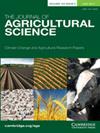玉米基因型对黑棘双翅虫组成性抗性的抗虫性研究
IF 2.2
4区 农林科学
Q2 AGRICULTURE, MULTIDISCIPLINARY
引用次数: 0
摘要
玉米是世界上最重要的农作物之一,然而,它会受到许多食植物昆虫的影响,给生产造成经济损失。黑棘Diceraeus melacanthus属于危害玉米的害虫复合体。本研究旨在评价17个玉米基因型对黑棘蝽的抗虫性。试验在温室内进行,试验中有2期玉米植株和成虫。除了评估植物的物理和形态学因素(如组织硬度、刺数和比色因素)外,还进行了吸引力和食物偏好的生物测定。基因型30A37、IAC 8390、Defender、NS 77和Supremo Tg在自由选择和不选择试验中表现出最大的抗异种效应,其中Defender和Supremo Tg可能是由于植物组织硬度等形态原因造成的。虽然IAC 8390基因型也表现出巨大的耐药潜力,但无法确定其原因,因此应进行更多的研究,以评估可能使其具有这种特性的化学成分。本文章由计算机程序翻译,如有差异,请以英文原文为准。
Antixenosis in Constitutive Resistance in Maize Genotypes to the Stink Bug Diceraeus melacanthus
Corn is one of the most important agricultural crops in the world, however, it can be affected by numerous phytophagous insects that causing economic losses in production. Diceraeus melacanthus belongs to the complex of pests that attack maize. The objective of this work was to evaluate 17 maize genotypes regarding the effects of antixenosis resistance to the stink bug D. melacanthus. The experiments were carried out in a greenhouse with maize plants in stage V2 and adult stink bugs. Bioassays of attractiveness and food preference were carried out, in addition to evaluating physical and morphological factors of the plants, such as tissue hardness, number of punctures and colorimetric factors. Genotypes 30A37, IAC 8390, Defender, NS 77 and Supremo Tg were the ones that expressed the greatest antixenotic effects in tests free choice and no-choice, among these Defender and Supremo Tg due to possible morphological causes such as plant tissue hardness. Although the IAC 8390 genotype also presents great potential for resistance, it was not possible to attribute its causes, so more studies should be conducted to evaluate the possible chemical constituents that give them this characteristic.
求助全文
通过发布文献求助,成功后即可免费获取论文全文。
去求助
来源期刊

Journal of Agricultural Science
农林科学-农业综合
CiteScore
2.80
自引率
5.00%
发文量
68
审稿时长
1.4 months
期刊介绍:
The Journal of Agricultural Science publishes papers concerned with the advance of agriculture and the use of land resources throughout the world. It publishes original scientific work related to strategic and applied studies in all aspects of agricultural science and exploited species, as well as reviews of scientific topics of current agricultural relevance. Specific topics of interest include (but are not confined to): all aspects of crop and animal physiology, modelling of crop and animal systems, the scientific underpinning of agronomy and husbandry, animal welfare and behaviour, soil science, plant and animal product quality, plant and animal nutrition, engineering solutions, decision support systems, land use, environmental impacts of agriculture and forestry, impacts of climate change, rural biodiversity, experimental design and statistical analysis, and the application of new analytical and study methods (including genetic diversity and molecular biology approaches). The journal also publishes book reviews and letters. Occasional themed issues are published which have recently included centenary reviews, wheat papers and modelling animal systems.
 求助内容:
求助内容: 应助结果提醒方式:
应助结果提醒方式:


